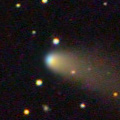
|
Now it is so bright as 9.5 mag (Jan. 13, Juan Jose Gonzalez). It keeps as bright as 9-10 mag for a long time until spring. It will be observable in good condition for a long time after this in the Northern Hemisphere. It keeps visible visually for one year until autumn.
Date(TT) R.A. (2000) Decl. Delta r Elong. m1 Best Time(A, h)
Jan. 16 14 14.63 31 54.0 2.224 2.525 96 9.4 5:38 (282, 78)
Jan. 23 14 26.53 34 51.6 2.204 2.561 99 9.4 5:36 (269, 81)
|
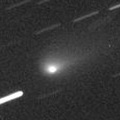
|
Now it is so bright as 9.7 mag (Jan. 13, Juan Jose Gonzalez). It keeps observable bright as 9-10 mag in a good condition for a long time until spring. It keeps observable until autumn when it fades down to 16 mag.
Date(TT) R.A. (2000) Decl. Delta r Elong. m1 Best Time(A, h)
Jan. 16 12 42.54 -2 48.8 1.088 1.641 104 10.2 5:02 ( 0, 52)
Jan. 23 12 56.92 -3 52.1 1.025 1.627 108 10.0 4:48 ( 0, 51)
|
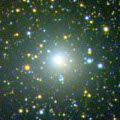
|
It reached up to 7.7 mag in summer (Aug. 13, Chris Wyatt). It is fading now. It has already faded down to 10.2 mag (Dec. 11, Carlos Labordena). Now it is not observable. In the Southern Hemisphere, it will appear in the morning sky in late February, then it keeps observable for a long time. But in the Northern Hemisphere, it is only observable in the low sky in spring, then it will never be observable again.
Date(TT) R.A. (2000) Decl. Delta r Elong. m1 Best Time(A, h)
Jan. 16 19 47.41 -19 31.8 4.618 3.635 1 10.6 5:38 (282,-17)
Jan. 23 19 51.76 -20 9.8 4.645 3.669 6 10.7 5:36 (286,-13)
|
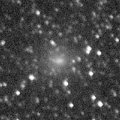
|
It reached up to 8.4 mag in October (Oct. 20, Marco Goiato). Now it is fading. But it is bright as 10.5 mag still now (Jan. 11, Carlos Labordena). In the Northern Hemisphere, it keeps observable in the low sky until February when it fades down to 13.5 mag.
Date(TT) R.A. (2000) Decl. Delta r Elong. m1 Best Time(A, h)
Jan. 16 22 30.05 -12 23.6 2.346 1.700 39 11.6 18:40 ( 60, 18)
Jan. 23 22 48.65 -10 25.6 2.425 1.742 36 12.0 18:46 ( 65, 16)
|
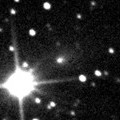
|
Now it is bright as 11.5 mag (Jan. 12, Juan Jose Gonzalez). In the Northern Hemisphere, it keeps observable in good condition until spring.
Date(TT) R.A. (2000) Decl. Delta r Elong. m1 Best Time(A, h)
Jan. 16 5 42.34 11 1.1 1.084 1.987 147 12.1 21:59 ( 0, 66)
Jan. 23 5 41.54 11 56.8 1.126 1.991 141 12.2 21:31 ( 0, 67)
|
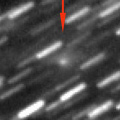
|
It was very bright visually as 9.2 mag (Nov. 18, Juan Jose Gonzalez) and 11.6 mag (Dec. 7, Chris Wyatt) until around the perihelion passage. However, now it is so faint as 16.3 mag (Jan. 5, Hidetaka Sato), and looks almost completely stellar with no coma. In the Southern Hemisphere, it is observable in the excellent condition after January. In the Northern Hemisphere, it is not observable now. But it will appear in the morning sky in late January, then it keeps observable while fading gradually.
Date(TT) R.A. (2000) Decl. Delta r Elong. m1 Best Time(A, h)
Jan. 16 10 24.82 -53 47.0 0.198 1.031 98 12.6 2:47 ( 0, 0)
Jan. 23 9 33.01 -36 4.4 0.226 1.120 121 13.6 1:27 ( 0, 18)
|
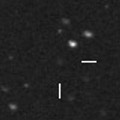
|
It is expected to reach up to 10 mag and to be observable in good condition in spring. Now it is not observable. It will appear in the morning sky at 13 mag in late January.
Date(TT) R.A. (2000) Decl. Delta r Elong. m1 Best Time(A, h)
Jan. 16 17 59.92 -23 31.7 2.872 2.030 25 13.4 5:38 (300, 1)
Jan. 23 18 8.68 -21 29.1 2.745 1.965 30 13.1 5:36 (301, 6)
|
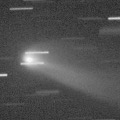
|
An outburst occured on Oct. 13, and it reached up to 8.5 mag on Oct. 15 (Toru Yusa). The central nucleus shined like a bright star, and the dust coma looked like 17P/Holmes in outburst. However, the comet returned to the normal state within a few days. Now it is 13.0 mag (Jan. 15, Carlos Labordena). It will fade out rapidly, and will be fainter than 14 mag in late January. In the Northern Hemisphere, it keeps observable in good condition for a long time until spring when it becomes fainter than 18 mag.
Date(TT) R.A. (2000) Decl. Delta r Elong. m1 Best Time(A, h)
Jan. 16 5 31.54 12 23.2 1.074 1.967 145 13.4 21:48 ( 0, 68)
Jan. 23 5 31.14 13 53.7 1.174 2.024 139 13.9 21:20 ( 0, 69)
|

|
Outbursts occured repeatedly since September, and it keeps visible visually. It is bright as 12.0 mag still now (Dec. 12, Juan Jose Gonzalez).
Date(TT) R.A. (2000) Decl. Delta r Elong. m1 Best Time(A, h)
Jan. 16 9 46.53 11 49.9 5.311 6.188 150 13.6 2:07 ( 0, 67)
Jan. 23 9 43.74 11 58.0 5.263 6.189 158 13.5 1:36 ( 0, 67)
|
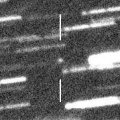
|
It is expected to be bright as 9-10 mag in the northern sky in March and April. It must have been observable in the morning sky until mid December. However, few observations have been reported since October. Now it is not observable. It will appear in the morning sky at 13.5 mag in late January, then it will brighten rapidly. In the Southern Hemisphere, it will be observable in the low sky after the perihelion passage only.
Date(TT) R.A. (2000) Decl. Delta r Elong. m1 Best Time(A, h)
Jan. 16 19 32.86 1 47.8 2.294 1.443 23 14.4 5:38 (267, -2)
Jan. 23 19 40.52 3 46.8 2.164 1.341 25 14.0 5:36 (268, 3)
|

|
Appearing in the morining sky. It will brighten up to 12-13 mag in summer. But it locates somewhat low in the Northern Hemisphere.
Date(TT) R.A. (2000) Decl. Delta r Elong. m1 Best Time(A, h)
Jan. 16 17 32.81 -23 44.5 3.237 2.456 31 14.0 5:38 (305, 6)
Jan. 23 17 47.40 -24 8.9 3.184 2.452 35 14.0 5:36 (307, 8)
|
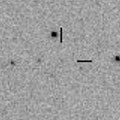
|
Now it is 15.6 mag (Dec. 6, A. Maury, J. B. de Vanssay, F. Mallia, F. Kugel). It will be 14 mag from winter to spring in 2010. But the condition is bad. Now it is not observable in the Northern Hemisphere. But in the Southern Hemisphere, it keeps observable until mid January. In the Northern Hemisphere, it will appear in the morning sky at 15 mag in late May in 2010, then it keeps observable while fading gradually after that.
Date(TT) R.A. (2000) Decl. Delta r Elong. m1 Best Time(A, h)
Jan. 16 22 2.61 -24 41.7 2.536 1.762 30 14.2 18:40 ( 56, 4)
Jan. 23 22 17.06 -21 17.6 2.560 1.746 27 14.2 18:46 ( 61, 3)
|

|
It brightened up to 11 mag in spring and summer in 2009. Appearing in the morninig sky again. It keeps observable after this until autumn when it becomes fainter than 18 mag while fading gradually. But it locates somewhat low in the Northern Hemisphere.
Date(TT) R.A. (2000) Decl. Delta r Elong. m1 Best Time(A, h)
Jan. 16 17 38.42 -25 31.6 3.304 2.507 30 14.6 5:38 (305, 4)
Jan. 23 17 52.27 -25 41.8 3.278 2.529 34 14.7 5:36 (307, 6)
|
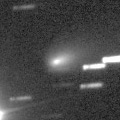
|
It has brightened much faster than expected. Now it is so bright as 11.8 mag (Dec. 12, Juan Jose Gonzalez). It will be fading after January. It keeps observable in good condition for a long time. But it may fade out very rapidly.
Date(TT) R.A. (2000) Decl. Delta r Elong. m1 Best Time(A, h)
Jan. 16 10 39.61 10 12.5 0.581 1.467 137 15.0 2:59 ( 0, 65)
Jan. 23 10 41.23 12 27.4 0.584 1.502 145 15.4 2:33 ( 0, 67)
|
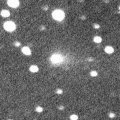
|
Now it is 13.4 mag, already visible visually (Dec. 24, Marco Goiato). It will be observable at 15 mag in good condition in winter and spring.
Date(TT) R.A. (2000) Decl. Delta r Elong. m1 Best Time(A, h)
Jan. 16 4 49.96 16 0.9 1.221 2.054 137 15.0 21:07 ( 0, 71)
Jan. 23 4 49.43 16 48.6 1.252 2.031 130 15.0 20:39 ( 0, 72)
|

|
It brightned up to 10 mag from late 2008 to early 2009. Now it is fading. But it is still bright as 16.0 mag (Dec. 1, Ken-ichi Kadota). It will be observable in good condition again in winter at 15-16 mag. Then it may be still visible visually.
Date(TT) R.A. (2000) Decl. Delta r Elong. m1 Best Time(A, h)
Jan. 16 10 18.09 3 20.1 4.634 5.424 139 15.3 2:38 ( 0, 58)
Jan. 23 10 14.64 3 15.2 4.621 5.478 147 15.4 2:07 ( 0, 58)
|
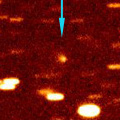
|
It had been brightening as expected until Dec. 29 when it was 16.4 mag (Ken-ichi Kadota). However, it was reported bright as 14.2 mag on Jan. 3 (W. Hasubick). Maybe an outburst. The condition of this apparition is bad. It will reach up to 11-12 mag from spring to autumn in 2010, but it is not observable. It will be getting brighter gradually in the evening sky, but it will be too low to observe in January at 15 mag.
Date(TT) R.A. (2000) Decl. Delta r Elong. m1 Best Time(A, h)
Jan. 16 22 5.27 1 4.2 2.859 2.194 39 15.6 18:40 ( 76, 22)
Jan. 23 22 18.05 1 54.9 2.861 2.145 36 15.4 18:46 ( 80, 18)
|
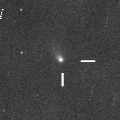
|
It brightened very rapidly. Now it is 14.8 mag and visible visually (Dec. 4, Juan Jose Gonzalez). It is observable at 15 mag in good condition in winter.
Date(TT) R.A. (2000) Decl. Delta r Elong. m1 Best Time(A, h)
Jan. 16 2 38.74 -8 1.0 1.319 1.755 98 15.4 18:57 ( 0, 47)
Jan. 23 2 51.26 -7 59.3 1.381 1.759 94 15.6 18:46 ( 2, 47)
|
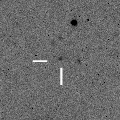
|
Now it is 16.8 mag (Dec. 20, J. M. Trigo-Rodriguez). It is expected to brighten rapidly and to be observable at 15 mag in good condition from winter to spring. However, it is a bit fainter than this ephemeris recently.
Date(TT) R.A. (2000) Decl. Delta r Elong. m1 Best Time(A, h)
Jan. 16 10 40.97 18 8.5 1.455 2.296 139 15.6 3:01 ( 0, 73)
Jan. 23 10 40.53 18 42.2 1.397 2.286 146 15.5 2:33 ( 0, 74)
|
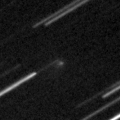
|
Now it is 15.7 mag (Dec. 27, Yasukazu Ikari). It will be observable at 15.5 mag in the evening sky until spring.
Date(TT) R.A. (2000) Decl. Delta r Elong. m1 Best Time(A, h)
Jan. 16 0 56.55 40 40.0 1.289 1.675 93 15.8 18:40 (115, 72)
Jan. 23 0 52.73 42 37.4 1.324 1.625 88 15.7 18:46 (117, 65)
|
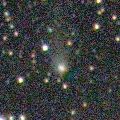
|
It brightened up to 11.5 mag in 2008 summer (Aug. 4, Marco Goiato). Now it is 15.8 mag (Dec. 18, A. Novichonok, A. Smirnov, S. Plaksa). It keeps observable in good condition for a long time in the Southern Hemisphere. Now it became observable again also in the Northern Hemisphere. It will keep 15-16 mag until spring.
Date(TT) R.A. (2000) Decl. Delta r Elong. m1 Best Time(A, h)
Jan. 16 4 48.55 -34 58.0 4.537 4.951 109 15.7 21:05 ( 0, 20)
Jan. 23 4 43.95 -33 21.3 4.639 5.003 106 15.8 20:33 ( 0, 22)
|
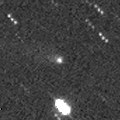
|
Now it is 16.8 mag (Dec. 18, Ken-ichi Kadota), a bit fainter than this ephemeris. It will be observable at 16 mag in good condition until spring.
Date(TT) R.A. (2000) Decl. Delta r Elong. m1 Best Time(A, h)
Jan. 16 15 41.52 21 17.3 3.129 3.010 74 15.8 5:38 (284, 56)
Jan. 23 15 38.70 21 48.3 3.046 3.038 80 15.7 5:36 (290, 62)
|
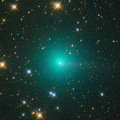
|
It brightened up to 6.7 mag in June (June 9, Marco Goiato). Now it is 14.6 mag (Dec. 31, Ken-ichi Kadota). It will be fading after this, and keeps observable until spring when it becomes fainter than 18 mag.
Date(TT) R.A. (2000) Decl. Delta r Elong. m1 Best Time(A, h)
Jan. 16 13 34.05 33 23.4 2.678 3.077 104 15.8 5:38 (297, 86)
Jan. 23 13 27.86 36 46.2 2.639 3.140 111 16.0 5:20 (180, 88)
|

|
Now it is 16.6 mag (Dec. 5, Ken-ichi Kadota). It was observed as 15-16 mag in early 2009. In 2010, it will be observable at 16 mag in good condition from winter to spring.
Date(TT) R.A. (2000) Decl. Delta r Elong. m1 Best Time(A, h)
Jan. 16 13 48.75 -4 28.9 3.491 3.606 88 15.9 5:38 (348, 50)
Jan. 23 13 52.72 -4 42.5 3.392 3.610 94 15.8 5:36 (357, 50)
|
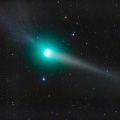
|
It passed near by the earth in late February in 2009, and it reached up to 4.9 mag (Feb. 23, Juan Jose Gonzalez). Now it is 16.2 mag (Dec. 22, R. Garcia). It will be low in the evening sky at 17-18 mag in spring.
Date(TT) R.A. (2000) Decl. Delta r Elong. m1 Best Time(A, h)
Jan. 16 4 53.71 20 39.6 3.970 4.755 138 15.9 21:10 ( 0, 76)
Jan. 23 4 46.78 20 30.6 4.129 4.822 130 16.1 20:36 ( 0, 76)
|

|
It brightened up to 13 mag and observed visually from 2007 to 2009. Due to the far distance, it is bright as 15.7 mag still now (Dec. 28, P. C. Sherrod). It will be observable in good condition again until spring.
Date(TT) R.A. (2000) Decl. Delta r Elong. m1 Best Time(A, h)
Jan. 16 13 23.91 35 5.2 7.258 7.605 107 16.1 5:38 (269, 89)
Jan. 23 13 21.32 35 55.7 7.200 7.637 112 16.1 5:13 (180, 89)
|
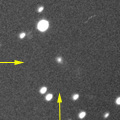
|
Now it is 16.6 mag (Jan. 16, Hidetaka Sato). It keeps observable at 15 mag for a long time in 2010.
Date(TT) R.A. (2000) Decl. Delta r Elong. m1 Best Time(A, h)
Jan. 16 17 6.34 11 29.9 5.508 4.960 51 16.2 5:38 (280, 34)
Jan. 23 17 12.85 12 22.3 5.419 4.937 56 16.1 5:36 (282, 38)
|
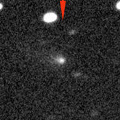
|
It brightened up to 11 mag in outburst in 2003. However, it does not seem to be so bright in this apparition. Now it is 16.2 mag (Dec. 26, Ken-ichi Kadota). It will be observable in good condition in winter. But it seems to brighten only up to 16 mag.
Date(TT) R.A. (2000) Decl. Delta r Elong. m1 Best Time(A, h)
Jan. 16 0 55.05 14 8.5 1.157 1.419 82 16.1 18:40 ( 49, 61)
Jan. 23 1 13.94 15 19.6 1.175 1.398 80 16.1 18:46 ( 56, 60)
|
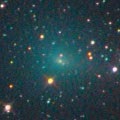
|
It brightened up to 8.8 mag in May and June (May 19, Juan Jose Gonzalez). It has already faded down to 15.7 mag (Dec. 23, Ken-ichi Kadota). It keeps observable in the evening sky for a long time until next spring when it becomes fainter than 18 mag.
Date(TT) R.A. (2000) Decl. Delta r Elong. m1 Best Time(A, h)
Jan. 16 0 13.36 -3 12.9 2.877 2.639 66 16.4 18:40 ( 45, 41)
Jan. 23 0 22.77 -2 5.4 3.002 2.680 61 16.7 18:46 ( 52, 38)
|
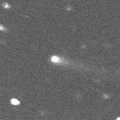
|
Now it is 15.9 mag (Dec. 18, Ken-ichi Kadota). This comet tends to brighten after the perihelion passage. It will be observable at 16 mag in 2010 and 2011. It is brighter than this ephemeris recently.
Date(TT) R.A. (2000) Decl. Delta r Elong. m1 Best Time(A, h)
Jan. 16 4 19.93 23 25.1 2.446 3.185 131 16.8 20:37 ( 0, 78)
Jan. 23 4 19.93 23 16.7 2.522 3.183 124 16.9 20:09 ( 0, 78)
|
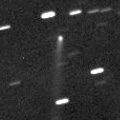
|
Now it is 16.9 mag (Dec. 22, Toru Yusa). It had a very long tail in 2009 in spite of the distance. It passed the perihelion in 2009, but it was brighter in 2008. It will be fading after this, and will be fainter than 18 mag in spring.
Date(TT) R.A. (2000) Decl. Delta r Elong. m1 Best Time(A, h)
Jan. 16 23 8.23 33 30.5 4.384 4.188 72 17.1 18:40 (102, 50)
Jan. 23 23 12.72 34 9.4 4.485 4.210 67 17.2 18:46 (106, 45)
|
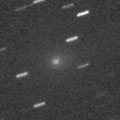
|
Fading slowly. Now it is 16.9 mag (Dec. 23, Ken-ichi Kadota). It keeps observable in good condition until February when it becomes fainter than 18 mag.
Date(TT) R.A. (2000) Decl. Delta r Elong. m1 Best Time(A, h)
Jan. 16 10 3.12 7 42.3 1.822 2.690 145 17.2 2:23 ( 0, 63)
Jan. 23 9 56.70 7 52.5 1.825 2.743 153 17.4 1:49 ( 0, 63)
|
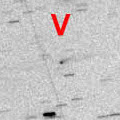
|
Now it is 17.9 mag (Dec. 5, Ken-ichi Kadota). It will be fainter than 18 mag in March.
Date(TT) R.A. (2000) Decl. Delta r Elong. m1 Best Time(A, h)
Jan. 16 11 14.68 17 48.0 1.381 2.165 131 17.3 3:34 ( 0, 73)
Jan. 23 11 12.72 19 15.0 1.367 2.209 139 17.3 3:05 ( 0, 74)
|
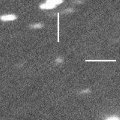
|
Now it is 18.0 mag (Dec. 19, Ken-ichi Kadota). It keeps observable at 17 mag for a long time from 2010 to 2012.
Date(TT) R.A. (2000) Decl. Delta r Elong. m1 Best Time(A, h)
Jan. 16 2 21.38 17 22.5 8.304 8.581 103 17.4 18:40 ( 2, 72)
Jan. 23 2 19.24 17 16.1 8.415 8.566 95 17.5 18:46 ( 28, 70)
|
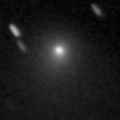
|
Getting higher again. But it will be fainter than 18 mag in April.
Date(TT) R.A. (2000) Decl. Delta r Elong. m1 Best Time(A, h)
Jan. 16 18 12.10 27 5.5 6.476 5.946 53 17.4 5:38 (255, 28)
Jan. 23 18 18.17 27 37.6 6.498 5.997 55 17.5 5:36 (257, 32)
|

|
Now it is 18.4 mag (Dec. 18, Yasukazu Ikari). It will be observable at 17.5 mag in good condition in early 2010 and early 2011.
Date(TT) R.A. (2000) Decl. Delta r Elong. m1 Best Time(A, h)
Jan. 16 5 20.85 20 40.0 2.723 3.575 145 17.7 21:37 ( 0, 76)
Jan. 23 5 18.12 20 46.7 2.780 3.567 137 17.8 21:07 ( 0, 76)
|

|
Now it is 17.7 mag (Dec. 21, Ken-ichi Kadota). It will be observable at 17.5 mag in good condition in winter.
Date(TT) R.A. (2000) Decl. Delta r Elong. m1 Best Time(A, h)
Jan. 16 10 1.40 33 44.7 2.163 3.045 148 17.8 2:21 ( 0, 89)
Jan. 23 9 57.72 34 29.7 2.139 3.053 153 17.8 1:50 ( 0, 89)
|
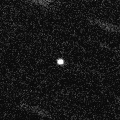
|
The condition is good in this apparition. It approached to the earth down to 0.38 A.U., and brightened up to 15.9 mag (Nov. 24, A. Sanchez). Now it is fading. It has already faded down to 17.3 mag (Jan. 15, Albert Sanchez Caso). It will be fainter than 18 mag soon.
Date(TT) R.A. (2000) Decl. Delta r Elong. m1 Best Time(A, h)
Jan. 16 2 46.58 16 43.0 0.829 1.476 108 18.0 19:05 ( 0, 72)
Jan. 23 3 7.52 17 49.9 0.928 1.535 106 18.3 18:58 ( 0, 73)
|

|
New periodic comet which brightened up to 14 mag in 2004 and 2005. It should be observable at 18 mag also around the aphelion. However, no observations have been reported since 2008 January. It seems to have faded out rapidly. Now it is fainter than 20.4 mag actually (Sept. 16, Leonid Elenin).
Date(TT) R.A. (2000) Decl. Delta r Elong. m1 Best Time(A, h)
Jan. 16 6 34.17 30 49.5 4.025 4.963 160 20.0 22:50 ( 0, 86)
Jan. 23 6 29.64 30 58.2 4.060 4.955 152 20.0 22:18 ( 0, 86)
|
|
![]()
 232P/2009 W1 ( Hill )
232P/2009 W1 ( Hill ) 107P/(4015) Wilson-Harrington
107P/(4015) Wilson-Harrington P/2004 F3 ( NEAT )
P/2004 F3 ( NEAT )![]()



































